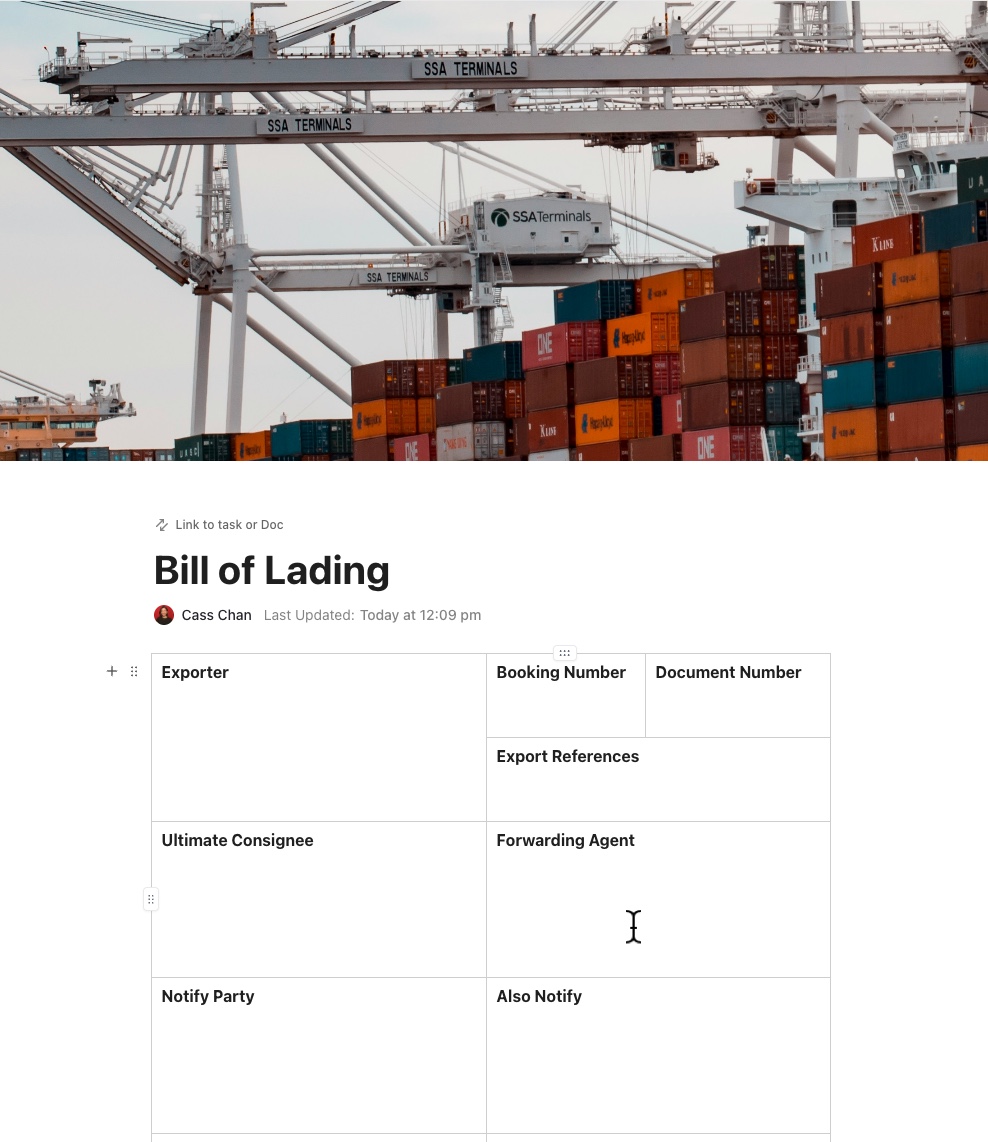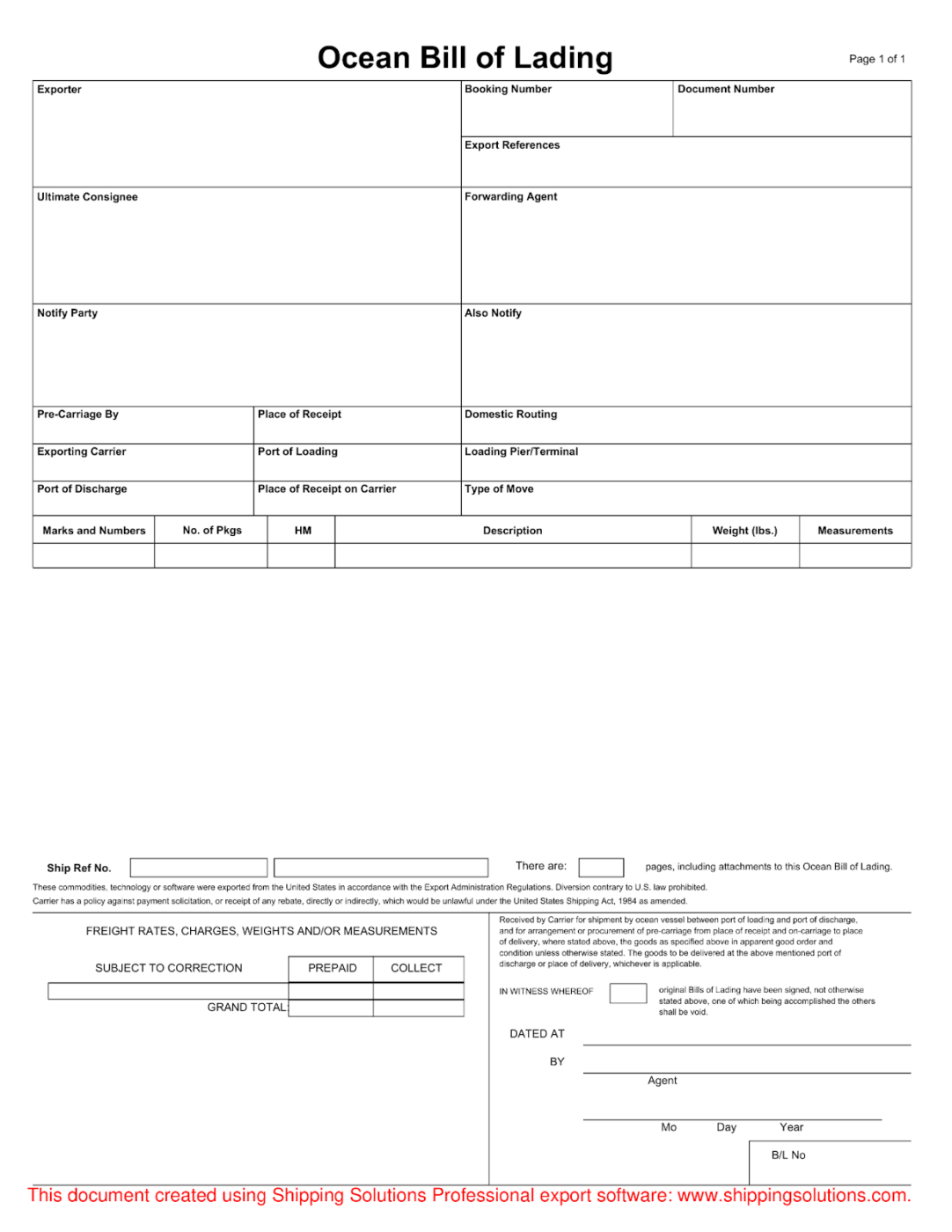Did you know more than 10,000 shipping containers get lost every year worldwide? If you don’t fill out the bill of lading correctly, you may have a hard time getting claims for your loss.
A bill of lading (BoL) is a crucial document when shipping physical inventory, whether raw materials or finished products. It is a legal agreement between the carrier and the recipient (consignee) and a documented receipt of the shipped inventory.
The BoL also helps you clearly define who is responsible for potential losses, delays, or damages. But not all bills of lading are the same. Depending on what and how you are exporting, you will need different types of bills of lading.
And that means a lot of paperwork and a high chance of making mistakes. That’s where the bill of lading templates come into play.
Whether you prefer working with documents in Microsoft Word, Excel, PDF, or Google Sheets, we’ve got you covered with the best bill of lading templates in various formats.
- What Makes a Good Bill of Lading Template?
- 8 Bill of Lading Templates
- 1. ClickUp Bill of Lading Template
- 2. Bill of Lading Template by CanadaCustoms
- 3. PDF Bill of Lading Template by PDFFiller
- 4. Excel Bill of Lading Form Template by WPSTemplate (Compatible with Google Sheets)
- 5. Bill Of Lading PDF Template by Fluix
- 6. Ocean Bill of Lading Template by Shipping Solutions
- 7. Bill of Lading Template by IncoDocs
- 8. Bill of Lading Template by SmartSheet for Word, Google Docs & PDF
- Other Logistics Tools: ClickUp
- Choosing the best bill of lading for your shipping requirements
What Makes a Good Bill of Lading Template?
A bill of lading (BoL) is a clear and comprehensive contract between the shipper, carrier, and consignee. It should include all the essential details required for a smooth shipment and potential legal recourse.
It’s an important legal document in the shipping and logistics industry, and there are several formats one can use. Pre-made BoLs ensure that every bit of information is presented as best as possible.
A good bill of lading template should have clearly defined sections, such as:
- Shipper details: Name, address, contact information, etc.
- Consignee information: Name, address, contact information, etc.
- Description of goods: Quantity, weight, dimensions, value, etc.
- Shipping instructions: Mode of transportation, delivery date, special requirements, etc.
A good bill of lading template should also comply with legal requirements, such as specifying:
- Liability limitations: The maximum amount that the carrier is liable for in case of loss or damage
- Indemnification provisions: The conditions under which the shipper or the consignee agrees to indemnify the carrier for any claims or damages
- Governing law clauses: The jurisdiction and the laws that apply to the transportation agreement
It should have a flexible design, allowing customization to accommodate different shipment needs. The template should ensure consistency across multiple shipments and help you prevent errors and inconsistencies by utilizing predefined drop-down lists, auto-fill features, data validation checks, etc.
You should look for a bill of lading template that is accessible across different platforms and is compatible with popular file formats, such as PDF and Excel, to enable easy sharing and distribution of the lading forms.
We have compiled a list of seven bills of lading templates that can help you simplify your shipping process.
8 Bill of Lading Templates
Whether you’re running a business using e-commerce software or working in the shipping industry, a lading document is vital. Here are 8 BOL templates to help get you started:
1. ClickUp Bill of Lading Template
If you are looking for a straightforward bill of lading, the ClickUp Bill of Lading Template is the best choice. This bill of lading template is structured as a detailed, non-negotiable shipping order for domestic shipments. It is ideal when the shipper and consignee are the same entity or the shipment invoice is pre-paid.
It gives you ample room to outline the terms and conditions of the shipment, including the agreed-upon shipping method, delivery terms, and special instructions.
It can help you streamline the shipping process and ensure compliance with domestic shipping regulations and industry standards.
2. Bill of Lading Template by CanadaCustoms
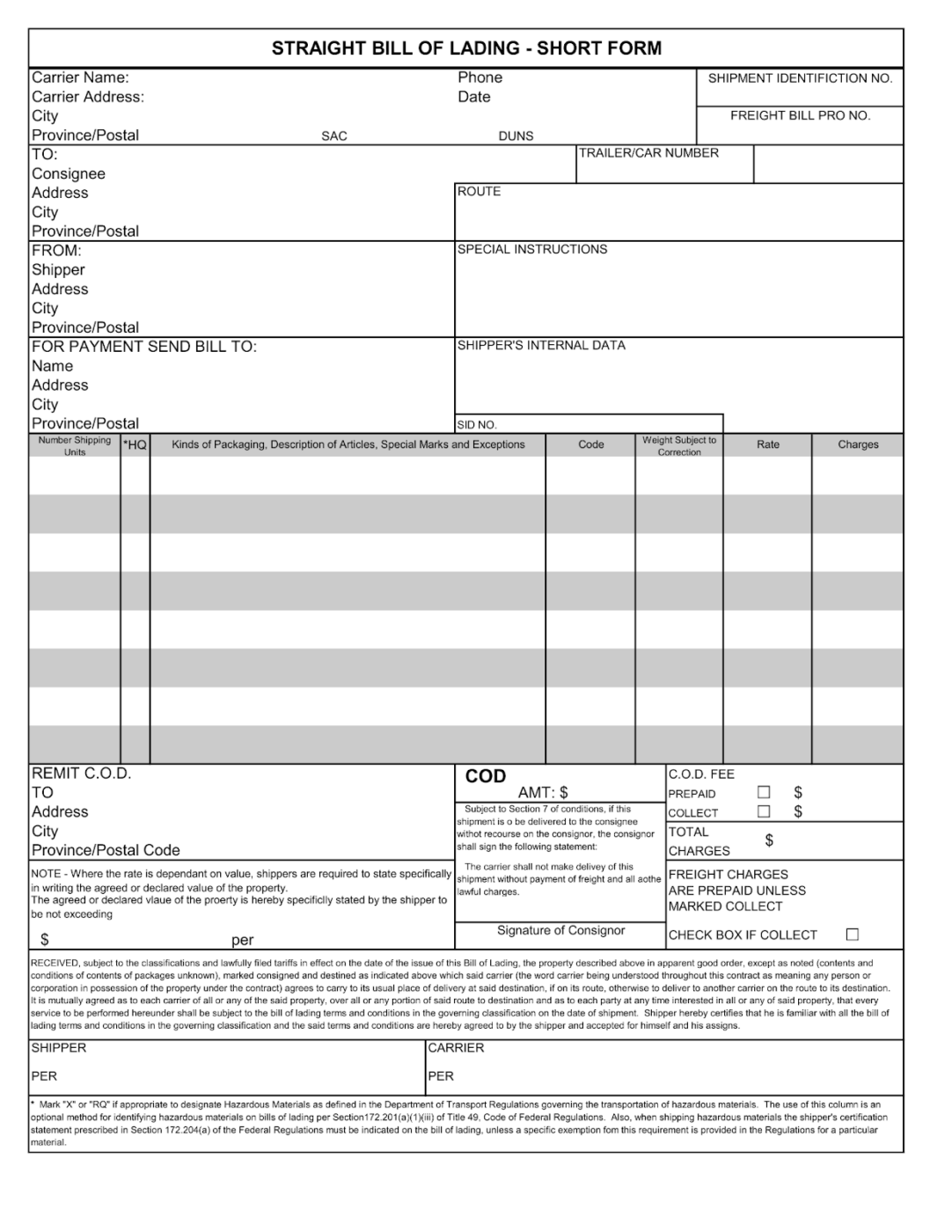
The Straight Bill of Lading Template by CanadaCustoms is a reliable document for shipping goods within Canada.
This template proves a non-negotiable, legally binding agreement between the shipper and the carrier, shielding you from potential misunderstandings, escalations, or breaches of duty.
Unlike the previous template, this BoL template is short and easy to use. Its standardized format minimizes the chances of errors.
This template includes all the essential details of the shipment, such as the identity and address of the shipper, consignee, and carrier, alongside the quantity, weight, description, and type of packaging used for the consignment.
Like all good bills of lading, it also includes the unique bill of lading number or the shipment identification number for easier tracking and reference.
3. PDF Bill of Lading Template by PDFFiller
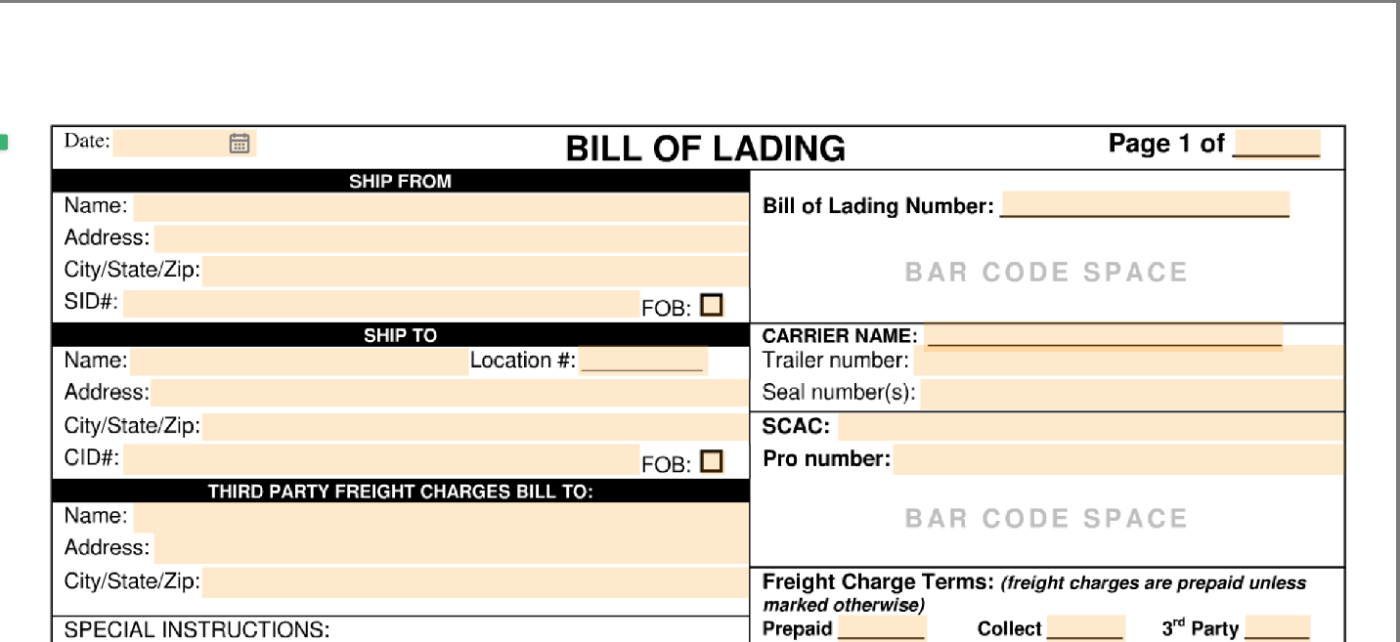
The PDF Bill of Lading Template by PDFFiller could be your go-to document for keeping track of your shipping goods. This template helps you record important details about your shipment for future reference. There are various sections to fill out, including customer order information, carrier information, trailer loaded and freight counted checklist, commodity description, and more.
The best part? It’s designed to manage multiple shipments in one document.
As a result, it streamlines your record-keeping process, making it an indispensable tool for logistics professionals.
Thanks to its PDF format, you can easily save copies of the information for your personal records and send them to anyone who needs them.
4. Excel Bill of Lading Form Template by WPSTemplate (Compatible with Google Sheets)

The Excel Bill of Lading Form Template by WPSTemplate lets you create professional and compliant shipping documents using the familiar Microsoft Excel interface. This template can also be used with Google Sheets.
With its user-friendly design, you can easily input and edit essential shipment details such as the shipper and consignee’s information and the description of goods, etc.
The template will help you automatically format your bill of lading, saving you time. Plus, you can edit and update the template as needed, making it suitable for different shipping situations.
This template follows the industry standards for bill of lading, ensuring compliance and legality in your shipping transactions. It’s suitable for documenting all shipping transactions— domestically or internationally.
You can adapt it quickly since it has a generic format that doesn’t cater to specific industries. This is your ideal choice if you run a business requiring a flexible bill of lading template for various shopping scenarios.
Save it on your logistics software to customize it quickly for different shipping requirements.
5. Bill Of Lading PDF Template by Fluix

Sometimes, you require an advanced bill of lading template with superior access controls to ensure the security of your shipment. If you’re shipping high-value goods or goods for a recipient who’d like to keep their details private, the Bill of Lading PDF template by Fluix is the right one for you.
Only authorized users can edit the freight and payment fields on the bill of lading, ensuring security and accuracy. This helps shippers customize shipping documentation easily.
You can use this template as a non-negotiable straight bill for any mode of transportation.
The clean layout of the template makes it visually appealing and intuitive. It’s much more flexible and customizable than your regular PDF templates.
You can also fill it out as a web form within the Fluix platform, a convenient and quick way to scale your shipping operations. While it may not have advanced fields for complex billing scenarios, it is the perfect choice for small and medium businesses and freelancers who need a versatile, access-controlled bill of lading template.
6. Ocean Bill of Lading Template by Shipping Solutions
This bill of lading template is designed specifically for ocean shipping.
The Ocean Bill of Lading template by Shipping Solutions is a comprehensive and reliable document that covers all necessary aspects for your sea shipment.
This template serves as both evidence of a legal contract for shipment and a document of title for the cargo. It mentions the details of the parties involved in the shipment, the description of the goods, and the routing instructions.
This bill of lading template also facilitates the transfer of ownership, the payment, and the customs clearance of the shipped goods so they can be delivered safely.
While it’s unsuitable for other modes of transportation, it’s ideal for companies regularly involved in international sea shipments.
7. Bill of Lading Template by IncoDocs
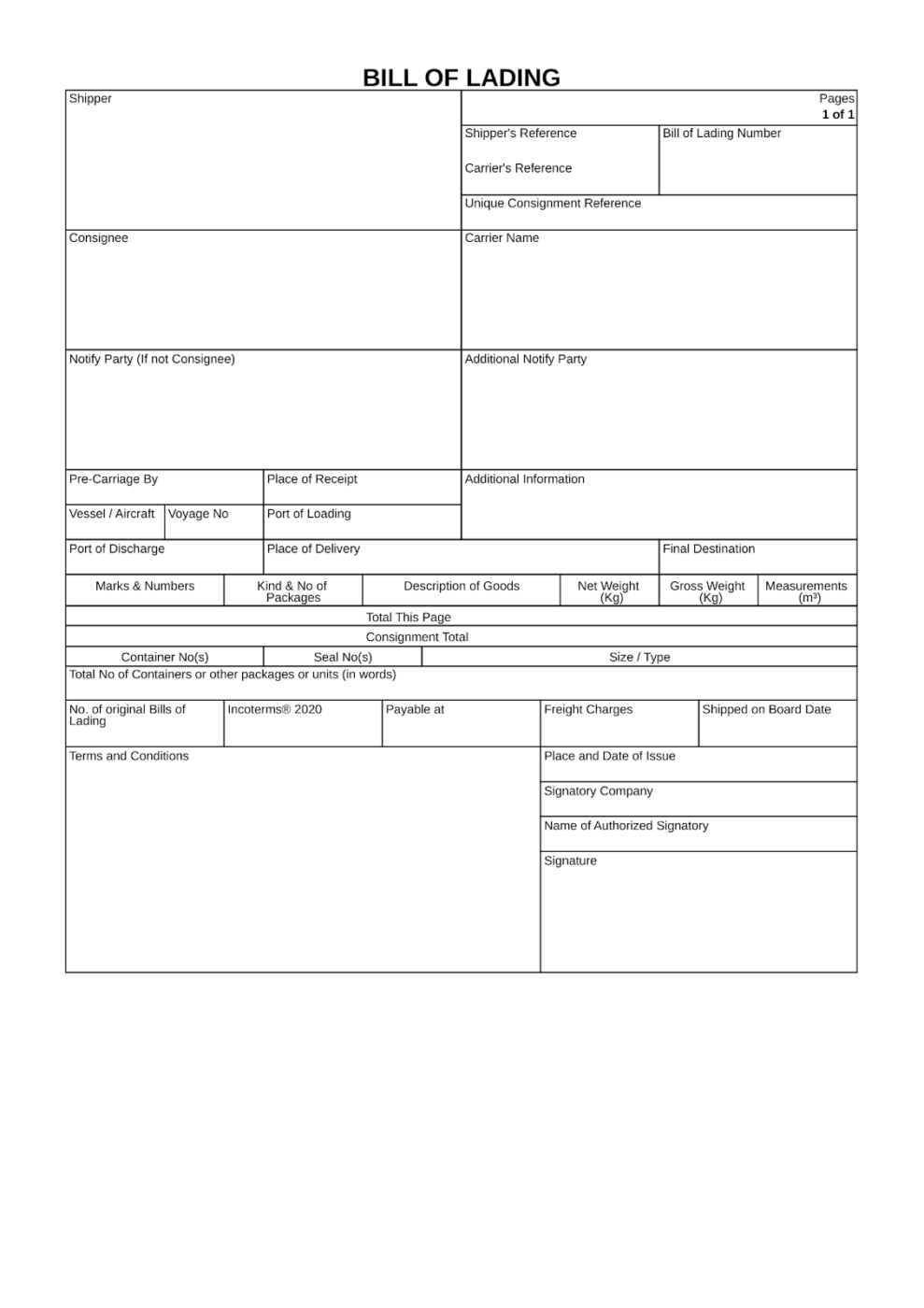
Do you want a bill of lading template that is easy to use and effective? Try the bill of lading template by IncoDocs. This template helps you easily document all the important details of your shipping transactions.
The versatile layout and clean design make it suitable for various shipping consignments. The template includes the information of the shipper, consignee, and notify party if the consignee is unavailable.
Whether you are a small or a large business, you can benefit from using the bill of lading by IncoDocs to streamline your shipping process.
8. Bill of Lading Template by SmartSheet for Word, Google Docs & PDF
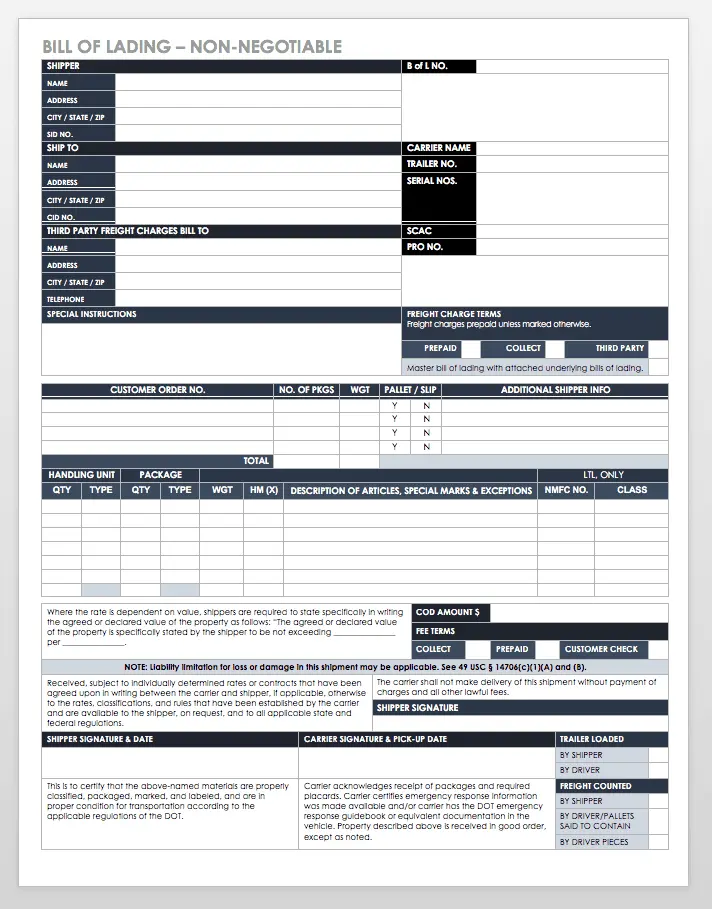
SmartSheet has a really nice looking and useful Bill of Lading template for Word, Google Docs and you can also download it as a PDF. Give it a look and use it if you find it useful for your purposes.
Other Logistics Tools: ClickUp
If only one template were enough to streamline all your logistical operations! We understand it’s not.
Your business needs a logistics management platform that can do it all.
Meet ClickUp. ClickUp is primarily a project management and collaboration platform that can be used to manage tasks, workflows, and collaboration related to creating and handling bills of lading and other documentation for your logistics workflows.
In other words, it can make everyday project execution easier by eliminating your busy work for logistics companies.
1. ClickUp’s project management capabilities

As a professional in the shipping industry, you’ve to collaborate and communicate with people around the world. ClickUp’s project management tool offers you, your team, and your clients a centralized platform to manage all your conversations, communication, tasks, workflows, handoffs, and more.
Consolidating all shipment information, customer details, and documents in one place eliminates the need for scattered spreadsheets and emails, improving visibility for all stakeholders.
Moreover, you can monitor shipment progress in real time using ClickUp’s Dashboards. These can be customized to display key metrics like delivery timelines, potential delays, and resource allocation.
This helps you set and achieve project management key performance indicators (KPIs) for your organization.
Finally, using ClickUp Automation will help you automate repetitive tasks like sending shipment updates to customers or generating reports, saving time and reducing human error.
2. ClickUp’s CRM suite

You can streamline your shipment business processes—client communications and billing workflows—through ClickUp’s CRM suite.
ClickUp CRM ensures you’ve customer information at your fingertips, including contact details, shipment history, and any past interactions. This gives your sales team a complete view of each customer and lets them personalize their approach in customer conversations.
Sales representatives can send emails, schedule calls, and track interactions directly within ClickUp. This ensures timely follow-ups and strengthens customer relationships.
Finally, you get access to customizable features, such as a hierarchy of folders and lists to organize client information better, filters and tags to locate specific billing information, and advanced reports to identify areas for improvement and optimize your business strategy.
3. ClickUp Docs

ClickUp Docs can transform into comprehensive knowledge repositories for your shipping company, storing essential documents like:
- Shipping policies: Clearly outline your company’s shipping terms, conditions, and limitations
- Standard operating procedures (SOPs): Document step-by-step processes for handling different shipment types, packaging procedures, and safety protocols
- Contracts and agreements: Store signed contracts with customers, vendors, and carriers for easy reference
Create templates with ClickUp Docs to manage warehouse inventory, track stock levels, and generate reports to optimize storage and prevent stockouts for logistics operations. You can add widgets to update workflows, assign tasks within your Docs, and more.
4. ClickUp’s time-tracking tool

If your company bills hourly, you can use ClickUp’s time-tracking feature to ensure payment collections and invoices are prepared accurately. This is also very helpful for project managers who work with contractors: Manage the different project phases and achieve your project management goals faster and more efficiently.
Time tracking can help you see how much time is spent processing each shipment, allowing for better cost estimation and resource allocation.
Analyze time data to pinpoint where shipments get delayed (e.g., customs clearance, paperwork processing). This helps streamline processes and improve overall efficiency.
Finally, with customizable workflow views and a work breakdown structure, you can track the time individual team members spend on shipping-related tasks to identify areas for improvement or recognize high performers.
Choosing the best bill of lading for your shipping requirements
Lading documents are more than just pieces of paper in the shipping and logistics industry—they are essential legal documents that oversee and protect the movement of goods worldwide.
Bill of lading templates, available in versatile formats such as Excel, PDF, and web-based platforms, offer businesses the tools they need to mitigate risks and simplify shipping.
No matter which bill of lading form you choose, ClickUp offers a variety of tools and features that can streamline your shipping and billing processes.
Manage tasks, track shipments in real-time, and experience a smoother, more efficient shipping process. Plus, ClickUp integrates seamlessly with your billing processes. Generate accurate invoices based on detailed time tracking data for each shipment. What are you waiting for? Sign up to ClickUp today!


